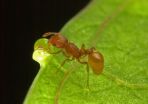(Press-News.org) A team from Disney Research and Carnegie Mellon University have devised a 3-D printer that layers together laser-cut sheets of fabric to form soft, squeezable objects such as bunnies, doll clothing and phone cases. These objects can have complex geometries and incorporate circuitry that makes them interactive.
"Today's 3-D printers can easily create custom metal, plastic, and rubber objects," said Jim McCann, associate research scientist at Disney Research Pittsburgh. "But soft fabric objects, like plush toys, are still fabricated by hand. Layered fabric printing is one possible method to automate the production of this class of objects."
The fabric printer is similar in principle to laminated object manufacturing, which takes sheets of paper or metal that have each been cut into a 2-D shape and then bonds them together to form a 3-D object. Fabric presents particular cutting and handling challenges, however, which the Disney team has addressed in the design of its printer.
The layered-fabric printer will be described at the Association for Computing Machinery's annual Conference on Human Factors in Computing Systems, CHI 2015, April 18-23 in Seoul, South Korea, where the report has received an honorable mention for a Best Paper award. In addition to McCann, the team included Huaishu Peng, a Ph.D. student in information science at Cornell University, and Scott Hudson and Jen Mankoff, both faculty members in Carnegie Mellon's Human-Computer Interaction Institute.
Last year at CHI, Hudson presented a soft 3-D object printer he developed at Disney Research that deposits layers of needle-felted yarn. The layered-fabric printing method, by contrast, can produce thicker, more squeezable objects.
The latest soft printing apparatus includes two fabrication surfaces - an upper cutting platform and a lower bonding platform. Fabric is fed from a roll into the device, where a vacuum holds the fabric up against the upper cutting platform while a laser cutting head moves below. The laser cuts a rectangular piece out of the fabric roll, then cuts the layer's desired 2-D shape or shapes within that rectangle. This second set of cuts is left purposefully incomplete so that the shapes receive support from the surrounding fabric during the fabrication process.
Once the cutting is complete, the bonding platform is raised up to the fabric and the vacuum is shut off to release the fabric. The platform is lowered and a heated bonding head is deployed, heating and pressing the fabric against previous layers. The fabric is coated with a heat-sensitive adhesive, so the bonding process is similar to a person using a hand iron to apply non-stitched fabric ornamentation onto a costume or banner.
Once the process is complete, the surrounding support fabric is torn away by hand to reveal the 3-D object.
The researchers demonstrated this technique by using 32 layers of 2-millimeter-thick felt to create a 2 ½-inch bunny. The process took about 2 ½ hours.
"The layers in the bunny print are evident because the bunny is relatively small compared to the felt we used to print it," McCann said. "It's a trade-off -- with thinner fabric, or a larger bunny, the layers would be less noticeable, but the printing time would increase."
Two types of material can be used to create objects by feeding one roll of fabric into the machine from left to right, while a second roll of a different material is fed front to back. If one of the materials is conductive, the equivalent of wiring can be incorporated into the device. The researchers demonstrated the possibilities by building a fabric starfish that serves as a touch sensor, as well as a fabric smartphone case with an antenna that can harvest enough energy from the phone to light an LED.
The feel of a fabricated object can be manipulated in the fabrication process by adding small interior cuts that make it easy to bend the object in one direction, while maintaining stiffness in the perpendicular direction.
INFORMATION:
For more information and a video of the process, please visit the project web site at http://www.disneyresearch.com/publication/a-layered-fabric-3d-printer-for-soft-interactive-objects.
About Disney Research
Disney Research is a network of research laboratories supporting The Walt Disney Company. Its purpose is to pursue scientific and technological innovation to advance the company's broad media and entertainment efforts. Vice Presidents Jessica Hodgins and Markus Gross manage Disney Research facilities in Los Angeles, Pittsburgh, Zürich, and Boston and work closely with the Pixar and ILM research groups in the San Francisco Bay Area. Research topics include computer graphics, animation, video processing, computer vision,
robotics, wireless & mobile computing, human-computer interaction, displays, behavioral economics, and machine learning.
Disney Research has demonstrated that battery-free, radio frequency identification (RFID) tags can be used to cheaply and unobtrusively determine how people use and interact with daily objects, enabling new types of interactive play, smart homes and work environments, and new methods for studying consumer shopping habits.
RFID tags are designed to simply report an identifying code when energized by an RFID reader, but a Disney Research team directed by Dr. Alanson Sample showed that the radio frequency signals transmitted by these tags provide a unique RF signature which ...
An international team of scientists have put forward a blueprint for a purely space-based system to solve the growing problem of space debris. The proposal, published in Acta Astronautica, combines a super-wide field-of-view telescope, developed by RIKEN's EUSO team, which will be used to detect objects, and a recently developed high-efficiency laser system, the CAN laser that was presented in Nature Photonics in 2013, that will be used to track space debris and remove it from orbit.
Space debris, which is continuously accumulating as a result of human space activities, ...
Half of all patients who survive a cardiac arrest experience problems with cognitive functions such as memory and attention. This has been shown by a major international study led from Lund University. Surprisingly, however, a control group comprising heart attack patients had largely the same level of problems. This suggests that it is not only the cardiac arrest and the consequent lack of oxygen to the brain that is the cause of the patients' difficulties.
The study led by Lund University involved 950 cardiac arrest patients in Europe and Australia. Six months after ...
This news release is available in Japanese.
It seems unnatural that a species could survive without having sex. Yet over the ages, evolution has endowed females of certain species of amphibians, reptiles and fish with the ability to clone themselves, and perpetuate offspring without males. Researchers at the at the Okinawa Institute of Science and Technology Graduate University (OIST) found that in species where females have evolved the ability to reproduce without males relatively recently, fertilization is still ensuring the survival of the maximum number of healthy ...
Scientists at the Vetmeduni Vienna investigated whether stomach ulcers in cattle are related to the presence of certain bacteria. For their study, they analyzed bacteria present in healthy and ulcerated cattle stomachs and found very few differences in microbial diversity. Bacteria therefore appear to play a minor role in the development of ulcers. The microbial diversity present in the stomachs of cattle has now for the first time been published in the journal Veterinary Microbiology.
Gastritis and stomach ulcers in humans are often caused by the bacterium Helicobacter ...
Breast cancer patients often display mild cognitive defects even before the initiation of chemotherapy. A new study by Ludwig-Maximilians-Universitaet (LMU) in Munich researchers now attributes the syndrome to post-traumatic stress induced by diagnosis of the disease.
A large number of studies have shown that cancer patients very often exhibit mild deficits of attention, memory and other basic cognitive functions. The phenomenon has generally been attributed to putative side-effects of chemotherapeutic drugs on the brain, and the condition is therefore popularly referred ...
WASHINGTON --Droperidol is safe and effective for calming violent and aggressive emergency patients, and the negative effects that garnered a black box warning from the Food and Drug Administration (FDA) are actually quite rare. A new study of the once ubiquitous, now scarce, sedating agent was published online Wednesday in Annals of Emergency Medicine ("The Safety and Effectiveness of Droperidol for Sedation of Acute Behavioral Disturbance in the Emergency Department").
"In our study, the two side effects that led to the black box warning - QT prolongation and torsades ...
CLEVELAND -- Anthony J. Furlan, MD, Chairman of Neurology and Co-Director of the Neurological Institute at University Hospitals (UH) Case Medical Center and Case Western Reserve University School of Medicine, who writes an accompanying editorial for five studies about endovascular stroke therapy published simultaneously in the New England Journal of Medicine (NEJM.org April 17), says these randomized clinical trials represent a breakthrough in showing the benefits of endovascular therapy for acute ischemic strokes.
"Now even endovascular skeptics will be convinced," Dr. ...
MANHATTAN, KANSAS -- The key to better cellphones and other rechargeable electronics may be in tiny "sandwiches" made of nanosheets, according to mechanical engineering research from Kansas State University.
Gurpreet Singh, assistant professor of mechanical and nuclear engineering, and his research team are improving rechargeable lithium-ion batteries. The team has focused on the lithium cycling of molybdenum disulfide, or MoS2, sheets, which Singh describes as a "sandwich" of one molybdenum atom between two sulfur atoms.
In the latest research, the team has found ...
The death toll in Cambodia under Khmer Rouge leader Pol Pot was most likely between 1.2 million and 2.8 million -- or between 13 percent and 30 percent of the country's population at the time -- according to a forthcoming article by a UCLA demographer.
April 17 is the 40th anniversary of the Khmer Rouge's capture of the capital of Cambodia -- beginning a four-year period that many consider to be a genocide. For decades, researchers have sought to pinpoint the death toll from political executions, disease, starvation and forced labor inflicted under the Khmer Rouge.
Conventional ...


